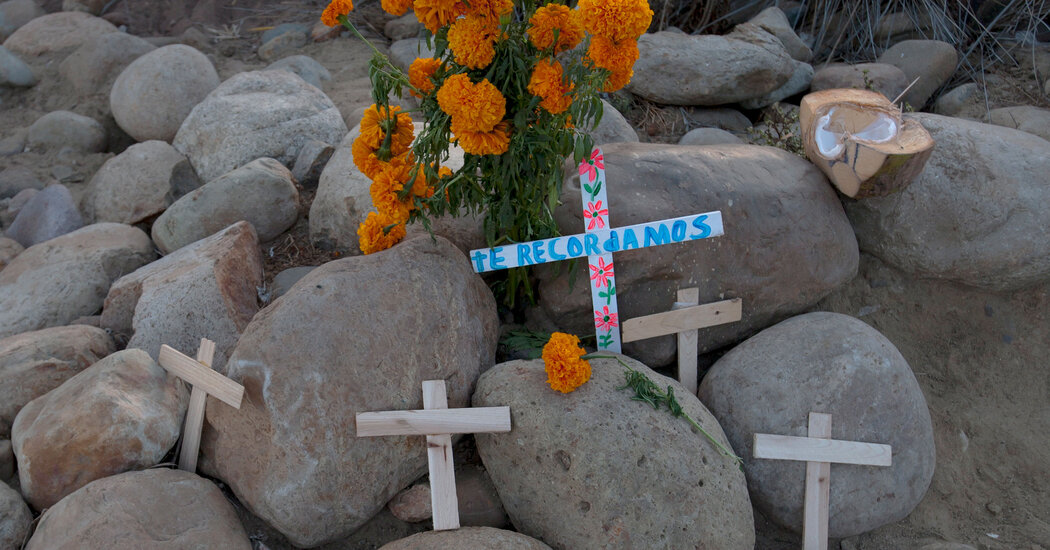Joyful. Ironic. Soulful. Intimate.
These are some of the words that have characterized Mexican attitudes toward death for decades, both within Mexico and the world over. Día de los Muertos, or Day of the Dead, a Mexican tradition in which people celebrate and mourn the departed, is famous for its festivity and color — so much so that it has been recognized by UNESCO as an exemplar of humanity’s cultural heritage. That it could not be more different from a self-serious funeral is a point of national pride.
Today, though, it’s become hard to find joy or irony in death in the face of the parade of homicides, disappearances and economies of extortion that punctuate life in Mexico. The combination of the holiday’s commercialization and the dark reality of national violence has made it trickier for people to observe Día de los Muertos, and especially to embrace its original meaning. The time has come to reclaim it.
Over the course of Mexico’s history, Día de los Muertos has provided an intimate space of encounter between the living and the dead at home and at grave altars. Families prepare lavish offerings of the deceased’s favorite food and drink, decorate altars with marigolds and sugar skulls, and gather in cemeteries to clean and adorn graves for the annual reunion. The holiday, which has its origins in a Catholic festival that was invented in 11th-century France, honors virtue on Nov. 1, All Saints Day, and then calls for remembrance of beloved sinners on Nov. 2, All Souls Day.
Although the Catholic framing of the festivities may have faded — a process spurred by the secularist revolution in mid-19th-century Mexico — it’s important to remember its original logic of dual remembrances. On All Saints Day, we honor the immaculate souls in heaven; on All Souls Day, originally conceived to benefit those in Purgatory, we remember our dearly departed as they were, with all of their virtues and vices. The altars that people set up to honor their departed often include loving nods to their more sinful appetites — a pack of cigarettes; a dish of rich, chocolaty mole; a shot of cane alcohol. We adore our dead with all of their foibles. We look to death in order to smile at the spectacle of life.
This idea became especially influential in Mexico’s post-revolutionary period, in the 1920s and 1930s, when many of the country’s most prominent intellectuals and artists, including the muralist Diego Rivera, embraced the Mexican people’s playful connection to death and to their dead as a source of inspiration. The iconography of everyday death, most famously conjured by the Mexican engraver José Guadalupe Posada, became a source of national pride: in the country’s hybrid Indigenous and European heritage, in its ability to lampoon the conceits of the living, in the blood that had been shed as it cast off dictatorship and exploitation, in the democratic nature of a death that comes for everyone.
But that was a hundred years ago, and now the rich tradition behind Día de los Muertos finds itself strained. Over the past several decades, the images that Mr. Rivera and others so cherished have been drained by commercial exploitation and a shallow nationalism that reduces the holiday to a tourist spectacle. The widely publicized Mexico City parade in which hordes of people dress up as skeletons, for instance, borrowed the concept from a scene in a James Bond film. But commercialization is not the steepest challenge facing Día de los Muertos.
More important is the sheer scale of everyday horror has shaken Mexico’s traditional relationship with death. Many Mexicans now perceive homicide and disappearance as fates that largely claim the lives of people who are either part of the country’s shady underworld or else foolishly careless. That misses the fact that Mexico’s illicit, informal and even formal economies often run on extortion, price-rigging, smuggling, illegal extraction, tax fraud, public graft, and the like. These practices rely on credible threats of violence to millions. Over the past two decades, hundreds of thousands of Mexicans have been killed and around 120,000 have been disappeared, with no end in sight. These dead are no longer the dearly departed; they are reduced to numbers. Today, the ancestral hunger of the souls to visit the living is overshadowed by the living’s simple desire to survive.
The problem that cartel wars, murders, disappearances and public displays of brutality present for Día de los Muertos is not trivial. Families with absent loved ones cannot visit or be visited by their dead in the cemetery or at a home altar. There is now a whole class of people — the families of the disappeared — whose capacity to mourn is hijacked by the cruelty of hope. In today’s Mexico, death is no longer a shared destination; it does not come equally to everyone.
The tradition of dialogue between the living and the dead on Día de los Muertos is far from gone, though, and the beloved holiday can still turn over a new leaf. To do so, all those who celebrate it must be capable of facing and processing the implications that Mexico’s many dead and disappeared have had on the fabric of society.
There is precedent for this. Mexicans have long used large public altars as spaces of communal mourning, as in the aftermath of the 1985 Mexico City earthquake. Activists have turned to Día de los Muertos as an occasion on which to protest femicide in the border city of Ciudad Juárez, migrant deaths on the U.S.-Mexico border, and the disappearance of 43 students in the town of Ayotzinapa in 2014. But such demonstrations have taken aim at the government, and the Mexican state has not shown itself capable of building peace. Mexican society must instead focus its attention on the violent economies that sustain the country’s ongoing national tragedy.
This is the new work of the dead: to force the living to see and address the causes of the nation’s collective wound. It is time to treat the hundreds of thousands of people who have been killed and disappeared not as an external phenomenon but as the victims of an economy rooted in violence. By asking the dead to bring our society back together, Día de los Muertos can once again become an essential, unifying force — not through nostalgic irony but through a necessary, profound act of collective reckoning.
Claudio Lomnitz is a professor of anthropology at Columbia University and the author of “Death and the Idea of Mexico.”
The Times is committed to publishing a diversity of letters to the editor. We’d like to hear what you think about this or any of our articles. Here are some tips. And here’s our email: [email protected].
Follow the New York Times Opinion section on Facebook, Instagram, TikTok, Bluesky, WhatsApp and Threads.
The post Mexico’s Day of the Dead Needs a New Life appeared first on New York Times.




